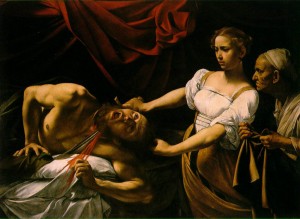
By Bob Hicks
Here’s the thing: If you’re an invading general with a roving eye, never invite a beautiful woman from the enemy city into your tent and then get so rip-roaring drunk you pass out.
Holofernes, this post’s for you.
Two intriguingly intertwined shows opened yesterday at the Portland Art Museum — The Bible Illustrated, maverick cartoonist R. Crumb‘s faithfully rendered graphic depiction of The Book of Genesis, and A Pioneering Collection: Master Drawings from the Crocker Art Museum, a gathering of almost 60 old-master drawings from the Sacramento museum’s impressive collections.
Friend of Scatter D.K. Row wrote vigorously in The Oregonian about Crumb’s project, and sometime in the next week or so the O will run my review of the Crocker exhibit. But first, let’s spend a little quality time with Holofernes, and Judith, and her faithful handmaiden, and one of our favorite Dutch artists, Hendrick Goltzius, an artist we admire so much we’ve featured him twice before: in this post about Hercules and baseball’s steroid scandal, and in this post about Wall Street’s bull and bear markets (we found his engraving of Icarus tumbling from the sky apropos).
 In brief: Holofernes, a star general for the Babylonian king Nebuchadnezzar, is laying siege to a city of the Israelites, and things are getting brutal. Alarmed and angry, Judith, an attractive young widow, sneaks out and into the enemy camp, where she charms Holofernes in his tent. She feeds him sweet cheeses, then gets him drunk as a skunk. While he’s sleeping it off she grabs his sword and lops off his head. When Holo’s army sees what’s happened it panics and heads for the hills. Judith saves the day!
In brief: Holofernes, a star general for the Babylonian king Nebuchadnezzar, is laying siege to a city of the Israelites, and things are getting brutal. Alarmed and angry, Judith, an attractive young widow, sneaks out and into the enemy camp, where she charms Holofernes in his tent. She feeds him sweet cheeses, then gets him drunk as a skunk. While he’s sleeping it off she grabs his sword and lops off his head. When Holo’s army sees what’s happened it panics and heads for the hills. Judith saves the day!
This story has fascinated artists for centuries, and everyone’s version seems singular. Why draw and paint pictorially? Because representational art tells stories, and there are as many different ways to tell a story as there are storytellers. Caravaggio, a genuine genius with a notorious violent streak, concentrated (inset) on the gorgeously bloody deed itself.